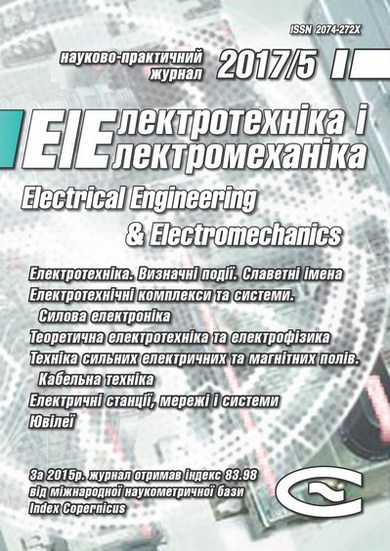FEATURES OF SELECTION OF CAPACITOR BANKS IN ELECTRIC NETWORKS WITH INTERHARMONIC SOURCES
DOI:
https://doi.org/10.20998/2074-272X.2017.5.11Keywords:
capacitor bank, reactive power compensation, filter-compensating device, higher harmonics, interharmonicsAbstract
Purpose. Development of a methodology for selecting capacitor bank parameters designed to compensate for reactive power, if there are sources of interharmonics in the electrical network. Development of a methodology for selecting the parameters of capacitor banks that are part of resonant filters of higher harmonics and interharmonics. Methodology. For the research, we used the decomposition of the non-sinusoidal voltage (current) curve into the sum of the harmonic components with frequencies as multiple of the fundamental frequency - higher harmonics, and not multiple fundamental frequencies - interharmonics. Results. Expressions are obtained for checking the absence of inadmissible overloads of capacitor banks by voltage and current in the presence of voltage (current) in the curve, along with higher harmonics, of the discrete spectrum of interharmonics. When selecting capacitor banks, both for reactive power compensation and for filter-compensating devices, the necessity of constructing the frequency characteristics of the input and mutual resistances of the electrical network for analyzing possible resonant phenomena is confirmed. Originality. The expediency of simplified calculation of the voltage variation at the terminals of the banks of the capacitors of the higher harmonics filters and interharmonics due to the presence of the reactor in the filters is substantiated. Practical value. The use of the proposed approaches will make it possible to resolve a number of issues related to the choice of parameters of capacitor banks in networks with nonlinear loads, including: ensuring reliable operation of capacitor banks when their parameters deviate from their nominal values, as well as deviations in the parameters of the supply network and sources of harmonic distortion; ensuring the absence of resonant phenomena at frequencies of both higher harmonics and interharmonics.
References
1. Zaytsev I. M. On compensation of reactive power of electrical equipment. Energy saving. Power engineering. Energy audit, 2010, no.11, pp. 66-69. (Ukr).
2. Omelchuk A.O., Skripnik A.M., Trondyuk V.S. Concerning the balance of reactive power in power grids in the new normative conditions of jet energy flows in Ukraine. Scientific Herald of National University of Life and Environmental Sciences of Ukraine. Series: Technique and energy of APK, 2011, no. 161, pp. 111-119. (Ukr).
3. Seema Dudhe. Reactive Power Compensation Techniques in Transmission lines. International Journal on Recent and Innovation Trends in Computing and Communication (IJRITCC), 2015, vol. 3, iss. 5, рр. 3224-3226.
4. Dixon J., Moran L., Rodriguez J., Domke R. Reactive Power Compensation Technologies: State-of-the-Art Review. Proceedings of the IEEE, 2005, vol.93, iss.12, рр. 2144-2164. doi: 10.1109/JPROC.2005.859937.
5. Davidov O.Yu., Byalobrzheskiy O.V. Analysis of reactive power compensation systems in electrical engineering systems. Transactions of Kremenchuk Mykhaylo Ostrogradskiy State University, 2010, no.3(62), pp. 132-136. (Ukr).
6. Zhezhelenko I.V., Saenko Yu.L. Kachestvo elektroenergii na promushlennukh predpriiatiiakh [Power quality in industrial plants]. Moscow, Energoatomizdat Publ., 2005. 261 p. (Rus).
7. Attachie J.C., Amuzuvi C.K. Using a Fixed and Switched-Capacitor Bank to Investigate Harmonic Resonance and Capacitor Bank Switching in a Distribution Network. Research Journal of Applied Sciences, Engineering and Technology, 2014, vol.7, iss.9, рр. 1900-1909. doi: 10.19026/rjaset.7.480.
8. Wilsun Xu, Xian Liu, Yilu Liu. Assessment of harmonic resonance potential for shunt capacitor applications. Electric Power Systems Research, 2001, vol.57, iss.2, рр. 97-104, doi: 10.1016/S0378-7796(01)00092-X.
9. Saenko Yu.L., Baranenko T.K., Baranenko E.V. Reduction of levels of harmonic distortions in electric networks with sources of interharmonics. Electrification of transport, 2012, no.3, pp. 78-83. (Ukr).
10. Zhezhelenko I.V., Saenko Yu.L., Baranenko T.K., Gorpinich A.V., Nesterovich V.V. Izbrannye voprosy nesinusoidal'nykh rezhimov v elektricheskikh setiakh predpriiatii [Selected issues of non-sinusoidal regimes in electric networks of enterprises]. Moscow, Energoatomizdat Publ., 2007. 296 p. (Rus).
Downloads
Published
How to Cite
Issue
Section
License
Copyright (c) 2017 Yu. L. Sayenko, T. K. Baranenko, D. N. Kalyuzhniy

This work is licensed under a Creative Commons Attribution-NonCommercial 4.0 International License.
Authors who publish with this journal agree to the following terms:
1. Authors retain copyright and grant the journal right of first publication with the work simultaneously licensed under a Creative Commons Attribution License that allows others to share the work with an acknowledgement of the work's authorship and initial publication in this journal.
2. Authors are able to enter into separate, additional contractual arrangements for the non-exclusive distribution of the journal's published version of the work (e.g., post it to an institutional repository or publish it in a book), with an acknowledgement of its initial publication in this journal.
3. Authors are permitted and encouraged to post their work online (e.g., in institutional repositories or on their website) prior to and during the submission process, as it can lead to productive exchanges, as well as earlier and greater citation of published work.





